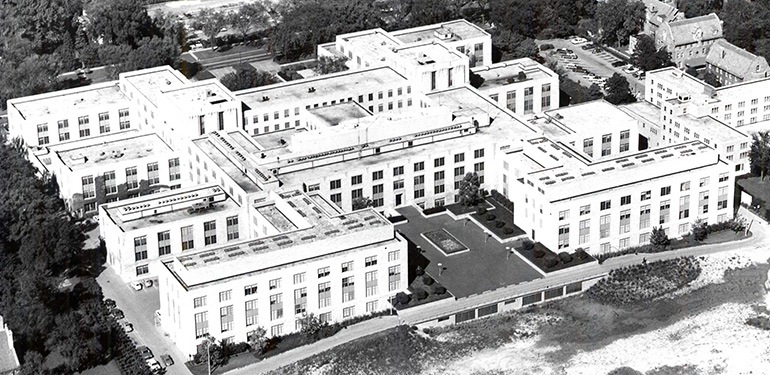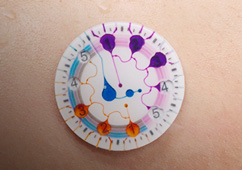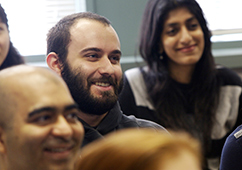History
Established in 1909, the McCormick School of Engineering has always fostered a culture in which practical problem solving and innovation drive new initiatives, research discoveries, and superior education.
Here are some highlights from McCormick’s timeline:
Jump to a Section
1909 – 1928
- Under the direction of John Fillmore Hayford, formerly of the U.S. Coast and Geodedic Survey, the College of Engineering is dedicated in 1909 in the newly constructed Swift Hall on Northwestern’s Evanston campus.
- The rigorous four- and five-year curriculum in either civil or mechanical-electrical engineering provides students with broad training in language and basic sciences, as well as professional and technical courses.
- In 1925, the college is renamed the School of Engineering and has a full-time faculty of nine. An attempted merger with the Armour Institute on Chicago’s South Side is not successful.
- In 1926-27, the Department of Civil Engineering is instituted. Bachelor of science degrees in engineering, mechanical engineering, and industrial engineering are established.
1929 – 1948
- The School of Engineering boasts an enrollment of 305, equal in size to peer programs at Harvard, Johns Hopkins, and Stanford.
- During the Great Depression, enrollment numbers decline and the Engineering Council for Professional Development removes Northwestern’s accreditation due to the school's bias toward theoretical learning.
- By 1937, Northwestern begins its courtship of inventor/industrialist Walter Patton Murphy. Murphy will donate nearly $7 million to found the new Technological Institute and a total of $28 million to the school with bequests upon his death.
- A cooperative education program designed by Charles Kettering and Herman Schneider requires graduates to work outside the classroom in technical positions. The undergraduate chemical engineering program is established.
- The Technological Institute building is completed in 1941. Its sprawling design and six wings (one for each academic department) will greatly influence the school’s continuing emphasis on interdisciplinary learning.
- The “Tech” building is used for military training during World War II. After the war, enrollment again increases.
1949 – 1968
- In 1953, the Department of Industrial Engineering is formed, as well as the Department of Metallurgy.
- In 1955, five department chairs resign in a disagreement over the current dean’s efforts to shift the school’s focus to graduate-level research and prohibit work on industrial projects.
- The university acquires its first mainframe computer in 1957, an IBM 650 located in Dearborn Observatory. Courses involving the computer are offered to graduate and undergraduate students.
- In 1959, the Department of Metallurgy becomes the Department of Materials Science, the first of its kind in the nation.
- The Cold War’s space race brings new emphasis on theoretical science. The Department of Mechanical Engineering does away with its wood shop and foundry in favor of laboratories for kinematics, vibrations and stress analysis, and gas dynamics.
- The Department of Defense funds the new Materials Research Center in 1960, which necessitates the building of two new wings for the “Tech” building.
- In 1963, the Department of Industrial Engineering changes its name to “industrial engineering and management sciences” and declares interdisciplinary interest in mathematics, economics, social sciences, and other specialties.
1969 – 1988
- In 1970, students stage a brief anti-war protest and conduct a sit-in in the dean’s office. Additional social unrest in the early 1970s leads to changes at the Technological Institute. Northwestern’s affirmative action program aims to recruit more African-American engineering graduate students.
- In 1971, the Department of Computer Science is established and a new Computer Science Laboratory opens.
- In 1977, the Seeley G. Mudd Library opens.
- The brief appointment of a female professor in civil engineering leads the administration to focus on encouraging minorities in engineering at the undergraduate level. Northwestern joins the Minorities in Engineering Opportunity Program in 1978.
- In 1978, the Master of Engineering Management Program is founded.
- The Catalysis Center opens in 1981, one of the first important interdisciplinary centers at the university. Additional centers follow, including the Center for Concrete and Geomaterials, the Center for Quality Engineering and Failure Prevention, the Center for Multiphase Fluid Flow and Transport, and the Laboratory for Artificial Intelligence.
- In 1983, the university president creates the Basic Industry Research Laboratory (BIRL) to capitalize on opportunities for interaction between technical research and industry. This begins a trend of increased commercial start-ups coming out of the school’s laboratories.
- In 1984, the Department of Biomedical Engineering is formally established, along with a designated BS degree.
1989 – 2008
- In 1989, the name of the school is changed to Robert R. McCormick School of Engineering and Applied Science, after receiving a $30 million grant from the Robert R. McCormick Foundation to rebuild the “Tech” building and develop new programs.
- In 1990, the school welcomes a freshman class that is 32 percent female and 12 percent underrepresented minorities. In addition, 53 students enter the new Master of Manufacturing Management (MMM) program, a joint venture with Kellogg.
- In 1993, freshman enrollment nears 330. U.S. News and World Report ranks the school seventh among private engineering schools.
- Launched in 1997, the Engineering First® program revolutionizes freshman year at McCormick with a project-based curriculum that stresses design, teamwork, collaboration, and synergy among academic domains. The program is nominated for a National Academy of Engineering award for educational excellence.
- The Ford Motor Company Engineering Design Center is funded in 2001 in honor of a $10 million gift from the Ford Motor Company. The building is dedicated in 2005 to house expanding programs in design, product development, entrepreneurialism, and other creativity-driven fields.
- In 2005, Julio M. Ottino, former chair of the Department of Chemical Engineering, is named dean.
- McCormick’s bourgeoning culture of design thinking is reflected in the founding of the Segal Design Institute in 2007, named in honor of a gift from Crate & Barrel co-founders Gordon and Carole Segal.
- The Farley Center for Entrepreneurship and Innovation is dedicated in 2008. The Initiative for Sustainability and Energy at Northwestern (ISEN) is organized to connect technical energy solutions with policy and outreach efforts.
2009 – Present
- Recognizing engineering’s role in addressing unprecedented global challenges, the McCormick School announces its new strategic vision: The Great Intersection™. This vision provides a framework to view the world and to focus research investment at the intersection of global challenges and the knowledge needed to solve them.
- In 2012, the full-time Master of Science in Analytics [later renamed Master of Science in Machine Learning and Data Science] is established to prepare students for the growing field of data science, information technology, and business of analytics.
- Continuing an ongoing partnership made possible through the Andrew W. Mellon Foundation, Northwestern University and the Art Institute of Chicago create the Center for Scientific Studies in the Arts. The new collaborative endeavor in conservation science pursues objects-based and objects-inspired scientific research.
- In 2013, McCormick establishes a new Master of Science in Robotics (MSR) degree, an interdisciplinary program designed to prepare college graduates for careers as robotics engineers.
- As of 2013, the McCormick School has 181 faculty members, 1662 undergraduate students, 908 master’s students, and 868 PhD students.
- In 2023, Christopher Schuh, former POSCO Professor of Materials Science and Engineering at the Massachusetts Institute of Technology, is named dean.





